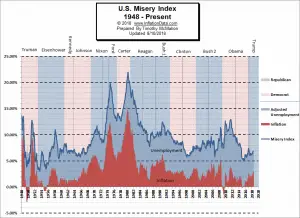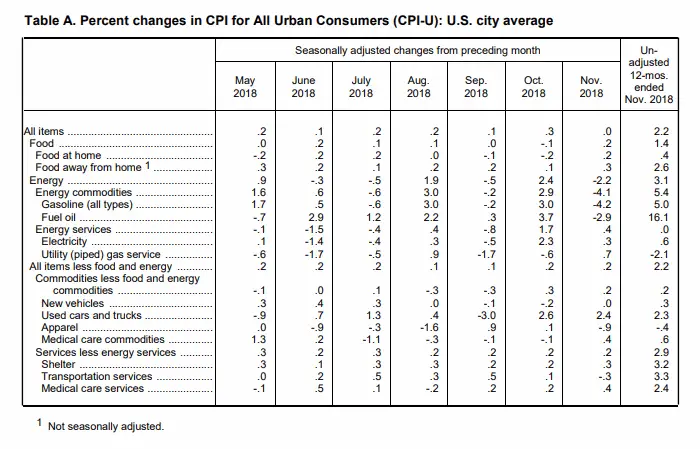The U.S. Bureau of Labor Statistics (BLS) released their monthly Consumer Price Index report on December 12th 2018, for the 12 month period through the end of November.
Annual Inflation is Down
- Annual inflation in November was 2.18% down from October’s 2.52% and below September’s 2.28% and the 2.70% in August.
- CPI was 252.038 in November below October, September and the 252.146 in August.
- Monthly Inflation for November was -0.33 October was 0.18% in September it was 0.12%, compared to virtually zero in November 2017.
- Next release January 11th
Monthly Inflation:
According the the BLS Commissioner’s report: “In November, the Consumer Price Index for All Urban Consumers was unchanged on a seasonally adjusted basis; rising 2.2 percent over the last 12 months, not seasonally adjusted. The index for all items less food and energy rose 0.2 percent in November (SA); up 2.2 percent over the year (NSA).”
Unfortunately the Commissioner’s report is somewhat confusing. It might make you think that annual inflation is unchanged for the month ending in November (which is untrue). But actually what it is saying is that the monthly Seasonally Adjusted Inflation Rate for November is zero. Meaning that although monthly inflation is -0.33% on an unadjusted basis it is average for the month of November thus on an adjusted basis it is zero.
When we have a negative monthly inflation rate that is deflationary on a monthly basis but disinflationary on an annual basis until the annual number turns negative as well then it becomes deflationary on an annual basis as well.
See the following table which shows the seasonally adjusted monthly inflation rates. Note that none are “Unchanged” from the previous month. But November is “Zero” for “All Items”. Note that the zero is seasonally adjusted the actual non-adjusted monthly inflation rate is -0.33%.
Seasonally Adjusted Inflation Table
From the table we can see that on a monthly Seasonally adjusted basis the biggest gainer is Used Cars and Trucks while the energy category was the biggest decliner with Energy overall down -2.2% and Gasoline down -4.2%.
Typically the monthly inflation rate is highest during the first quarter (January through March) with April and May often being among the high months but not always.
The lowest monthly inflation is typically during the last quarter (October through December) with June through September typically being moderate. Surprisingly, July came in negative in both 2016 and 2017. There was not a single negative July from 1950 through 2000 but there have been several since.
Not Seasonally Adjusted Monthly Inflation Rates
| Jan | Feb | Mar | Apr | May | Jun | Jul | Aug | Sep | Oct | Nov | Dec | |
| 2016 | 0.17% | 0.08% | 0.43% | 0.47% | 0.41% | 0.33% | (0.16%) | 0.09% | 0.24% | 0.12% | (0.16%) | 0.03% |
| 2017 | 0.58% | 0.31% | 0.08% | 0.30% | 0.09% | 0.09% | (0.07%) | 0.30% | 0.53% | (0.06%) | 0.00% | (0.06%) |
| 2018 | 0.54% | 0.45% | 0.23% | 0.40% | 0.42% | 0.16% | 0.01% | 0.06% | 0.12% | 0.18% | (0.33%) | NA |
See: Monthly Inflation Rate for more information and a complete table of Unadjusted Monthly Rates.
Not Seasonally Adjusted Inflation (by Category)
| Category | Annual | Monthly |
| All Items | 2.18% | -0.33% |
| Food | 1.4% | 0.0% |
| Energy | 3.1% | -4.4% |
| All Items less Food and Energy | 2.2% | 0.0% |
| Apparel | -0.4% | -3.2% |
| New Vehicles | 0.3% | 0.2% |
| Used Cars and Trucks | 2.3% | 1.1% |
| Shelter | 3.2% | 0.2% |
| Medical Services | 2.4% | 0.4% |
| Transportation Services | 3.3% | 0.0% |
Regional Inflation Information
The U.S. Bureau of Labor Statistics also produces regional data. So if you are interested in more localized inflation information you can find it here.
| AL | AK | AR | AZ | CA | CT | CO | DC | DE | FL | GA | GU | HI | IA |
| ID | IL | IN | KS | KY | LA | MA | MD | ME | MI | MN | MO | MS | MT |
| NC | ND | NE | NH | NJ | NM | NV | NY | OH | OK | OR | PA | PR | RI |
| SC | SC | SD | TX | UT | VA | VI | VT | WI | WA | WI | WV |
Food and Energy Breakdown
The BLS publishes an index entitled “All items Less Food and Energy” which often causes people some confusion. It doesn’t mean they stopped including food and energy in the Consumer Price Index. It just means that they have broken them out so you can compare their increase to other components. In this chart we can see the effects of food, energy and all other items on the total index. For more info see What is Core Inflation?
Misery Index

The misery index as of December 2018 (based on the most recent official government inflation and unemployment data for the 12 months ending in November) is at 5.88% down from 6.22%last month and even below the 5.98% in September. It is well below the 6.60% in August and the 6.85% and 6.87% in July and June respectively.
[Read More…]
You Might Also Like:
From InflationData.com
- What is Deflation?
- What is Disinflation?
- Cryptocurrencies and Inflation
- Did the Democrats Really Vote Against the Social Security Cost of Living Increase?
- Can Crypto Solve Venezuela’s Hyperinflation Problem?
- Cost of Living: LA and New York vs. The World
- What Impact (if any) Does Disruption have on Inflation?
- Debt and Inflationary Pressures: A Lesson in Economic Interactivity
- What Impact (if any) Does Disruption have on Inflation?
- Inflation Risk
Read more on UnemploymentData.com.
- European Unemployment Rates Q3- 2018
- Lost Wages? How to Get the Compensation You Deserve
- November Employment Gains Less Than Projected But…
- Valuable Career Benefits of Studying Abroad
- Getting Your Dream Job: Nailing the Interview
From Financial Trend Forecaster
- Move Aside Lithium – Vanadium Is The New Super-Metal
- U.S. Shale Has A Glaring Problem
- How Free is Your State?
- Oil Price Rally Boosts Electric Car Sales
- $100 Oil Is A Distinct Possibility
- Do the FED’s Interest Rates Affect the Stock Market?
- Technological Solution to 100 Year Old Oil Problem
From Elliott Wave University
- Have Smartphone Sales Peaked?
- Are Falling Oil Prices Really Good for the Stock Market?
- 1987 vs. 2018
- Bitcoin Breakdown May Push Prices Below $5000
- The Psychology of Volatility
From OptioMoney.com
- Big Family Getting Expensive? 4 Ways to Stay in the Green
- Getting a Motorcycle? Things to Cover Before Hitting the Road
- Finding the Right Material for Your Roof
- Undercut Utilities: How to Save on the Essentials
- Risk and Reward: Why You Should Be Investing Now
From Your Family Finances
- Financial Implications of Losing Your Mobility
- How to Develop a Millionaire Mindset
- Avoid being “house poor” by taking these 4 steps
- Productivity Hacks for Working from Home
- Dream Family Vacation: 5 Money Saving Tips That Add Up



Leave a Reply